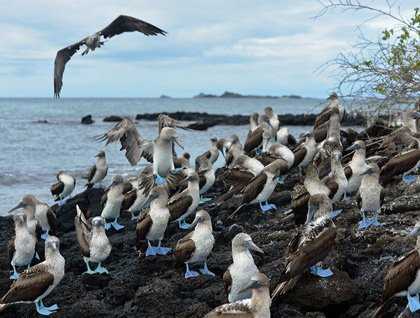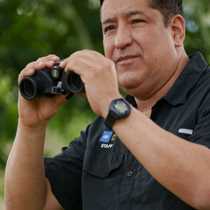This day in our expedition around this magical archipelago found us anchored in front of Cerro Dragon. Located in the northwestern side of Santa Cruz Island, Cerro Dragon, Spanish for Dragon’s Hill, is famous for the healthy population of Galápagos land iguanas that live there.
After breakfast, early in the morning, avoiding the heat of the day, we went for a hike looking for these so-called “dragon-like” iguanas. We were successful for we encountered several colorful individuals that were observed contentedly underneath prickly pear cacti or dozing in the equatorial sun that little by little showed up. Our guests were very surprised to see the very arid scenery that dominated this area as well. This dry landscape was in fact very different from the lush vegetation we observed yesterday, even though we were on the same island and at about the same altitude while in the littoral zone. In Galápagos, this natural phenomenon called rain shadow occurs because of the strong southwestern winds that affect the southern slopes of most of the islands of the archipelago.
In the late morning we snorkeled over to the nearby islets known as Guy Fawkes. There we found a huge underwater wall that teems with incredibly rich life, including Galápagos sea lions and many colorful invertebrates. Many reef fish species were seen as well.
In the afternoon the ship was repositioned to a different location not far from Cerro Dragon, El Eden. Zodiac rides and kayaking along the coast were options to explore the area. Today El Eden was spectacular! We found hundreds of blue-footed boobies resting peacefully on lava rocks after having a feeding frenzy. Hundreds of blue feet in contrast to the black lava of the surroundings made this sighting a surreal and unforgettable one.
At the end of this great day we went to the ship’s bow for a wine tasting on the house while circumnavigating Daphne Major. This small island is of great scientific interest for it was in this place where a famous couple of scientists Peter and Rosemary Grant have been studying Darwin finches most of their lives. They discovered, in a nutshell, that the size of beaks of these iconic birds can change in short periods of time adapting to drastic weather and availability of food on the island. This revolutionary study showed that evolution can take place not only in millions of years but also in extremely short time periods. A classical already science divulgation book by Jonathan Wiener entitled “The Beak of the Finch” beautifully narrates this extraordinary discovery and the life of the Grants on Daphne Major.
Late in the afternoon, once in the lounge we gathered for animated chatting talking about our new adventures and warm-hearted memories that all the day’s activities left on us. Our expedition will continue tomorrow, and we can hardly wait to see what it will bring to enrich our lives.







